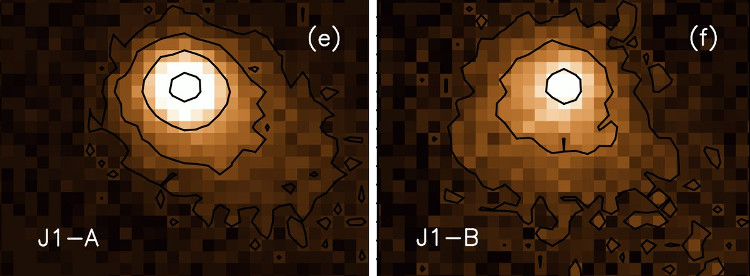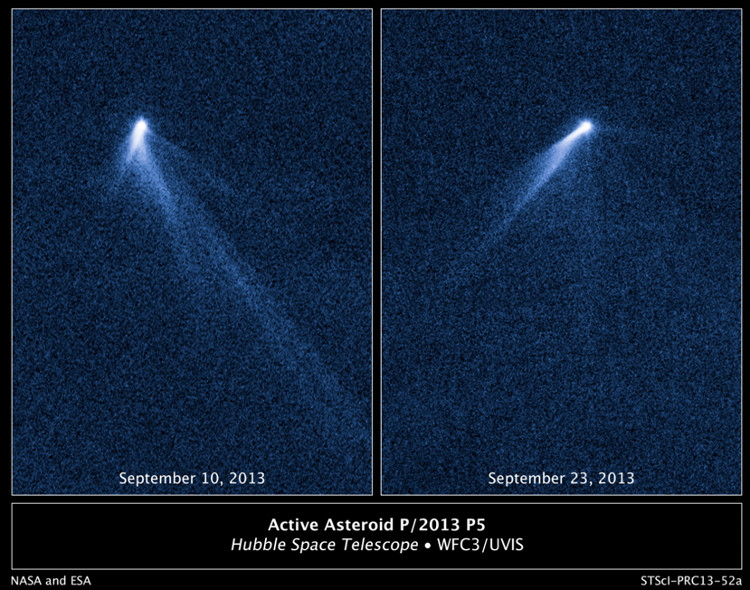Strange meteorite split itself
Scientists have discovered one of the youngest meteorite known in the Solar System, which is very strange when it splits itself and develops two individual comet-like tails.
This pair of meteorites is called P / 2016 J1 , discovered in 2016. It is a very uncommon meteorite type in the solar system asteroid belt, which is formed after the original meteorite breaks down. doubles as a result of being struck by another object, or due to an imbalance compared to the original orbit
The new discovery was made by observations at the Great Telescope of Canary Island and the Canadian-French-Hawaiian Telescope at Mauna Kea Volcanic Island in the Hawaiian Islands.

Images of two pieces of the P / 2016 meteorite J1 (designated as J1-A and J1-B) on May 15, 2016.It has a solid rock core and a dusty tail.(Photo: IAA-CSIC).
"We discovered this meteorite when it was not broken six years ago, making it the youngest known meteorite in the Solar System" - research leader and researcher Fernando Moreno Working at the Institute of Astrophysics Andalusia in Spain, said.
In addition, after a double break, this meteorite can also develop its own tail from gas dust for each of its half. This is more common in comets with ice cores than in meteorites with rocky cores.
"Both meteorites form a tail, meaning that it has an inner core structure similar to a comet. This is the first time we observe a pair of meteorites with simultaneous development in both. " Moreno said.
When studying the P / 2016 J1, astronomers discovered that meteorite pairs began to form tails from the end of 2015, early 2016, when they reached the near-point - which is the point where its orbit is closest to the Sun. . They still maintain the tail formation six to nine months later, then eventually split into two.

Hubble Space Telescope captures two P / 2013 P5 meteorites with a long tail.Astronomers say the case of P / 2016 J1 is similar.(Photo: NASA / ESA).
"In fact, the observed data about its previous orbital rotation (this meteorite has orbit around the Sun every 5.65 years in a round) shows that fragmentation has also occurred since it is near the point. Andalusia Research Institute representative said.
Although both meteorites do not have gravitational attraction to each other, they all have similar orbits around the Sun.
P / 2016 J1 has the same trajectory as most meteorites in the asteroid belt between Mars and Jupiter, which means it will be difficult to get close to the Sun to form a tail like comets.
"Instead, recent observations show that the creation of a dust gas tail is due to sublimation (the transition from solid to gaseous form) of ice inside the core that falls out during division. double " , Moreno explained.
- Tracing the past of exploding meteors in the Russian sky
- The meteorite explosions
- Russian meteorite rain brings virus to Earth?
- Do people with brains split apart, are their souls divided into two different halves?
- The meteorite pierced the roof
- The meteorite of the Earth age falls ... the roof
- Find the largest meteorite pieces in Russia
- Video: Unidentified object pierces meteorite in Ural sky
- Flocking to find meteorite fragments in Russia
- The sky is like a split in twilight in Canada
- A meteorite as big as the Great Pyramid is about to fly over the Earth
- Strange collection of animals
 Van Allen's belt and evidence that the Apollo 11 mission to the Moon was myth
Van Allen's belt and evidence that the Apollo 11 mission to the Moon was myth The levels of civilization in the universe (Kardashev scale)
The levels of civilization in the universe (Kardashev scale) Today Mars, the sun and the Earth are aligned
Today Mars, the sun and the Earth are aligned The Amazon owner announced a secret plan to build a space base for thousands of people
The Amazon owner announced a secret plan to build a space base for thousands of people